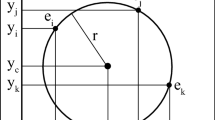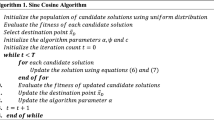Abstract
Hough transform has been the most common method for circle detection, exhibiting robustness, but adversely demanding considerable computational effort and large memory requirements. Alternative approaches include heuristic methods that employ iterative optimization procedures for detecting multiple circles. Since only one circle can be marked at each optimization cycle, multiple executions ought to be enforced in order to achieve multi-detection. This paper presents an algorithm for automatic detection of multiple circular shapes that considers the overall process as a multi-modal optimization problem. The approach is based on the artificial bee colony (ABC) algorithm, a swarm optimization algorithm inspired by the intelligent foraging behavior of honeybees. Unlike the original ABC algorithm, the proposed approach presents the addition of a memory for discarded solutions. Such memory allows holding important information regarding other local optima, which might have emerged during the optimization process. The detector uses a combination of three non-collinear edge points as parameters to determine circle candidates. A matching function (nectar-amount) determines if such circle candidates (bee-food sources) are actually present in the image. Guided by the values of such matching functions, the set of encoded candidate circles are evolved through the ABC algorithm so that the best candidate (global optimum) can be fitted into an actual circle within the edge-only image. Then, an analysis of the incorporated memory is executed in order to identify potential local optima, i.e., other circles. The proposed method is able to detect single or multiple circles from a digital image through only one optimization pass. Simulation results over several synthetic and natural images, with a varying range of complexity, validate the efficiency of the proposed technique regarding its accuracy, speed, and robustness.










Similar content being viewed by others
References
Atherton TJ, Kerbyson DJ (1993) Using phase to represent radius in the coherent circle Hough transform. In: Proceedings of the IEE colloquium on the Hough transform. IEE, London
Ayala-Ramirez V, Garcia-Capulin CH, Perez-Garcia A, Sanchez-Yanez RE (2006) Circle detection on images using genetic algorithms. Pattern Recogn Lett 27:652–657
Aytug H, Koehler GJ (2000) New stopping criterion for genetic algorithms. Eur J Oper Res 126:662–674
Becker J, Grousson S, Coltuc D (2002) From Hough transforms to integral transforms. In: Proceedings of the international geoscience and remote sensing symposium 2002 IGARSS_02, vol 3, pp 1444–1446
Bhowmick P, Bhattacharya BB (2008) Number-theoretic interpretation and construction of a digital circle. Discrete Appl Math 156:2381–2399
Biswas A, Das S, Abraham A, Dasgupta S (2010) Stability analysis of the reproduction operator in bacterial foraging optimization. Theoret Comput Sci 411:2127–2139
Bongiovanni G, Crescenzi P (1995) Parallel simulated annealing for shape detection. Comput Vis Image Underst 61(1):60–69
Bresenham JE (1987) A linear algorithm for incremental digital display of circular arcs. Commun ACM 20:100–106
Chen T-C, Chung K-L (2001) An efficient randomized algorithm for detecting circles. Comput Vis Image Underst 83:172–191
Chen Y, Jiang P (2010) Analysis of particle interaction in particle swarm optimization. Theoret Comput Sci 411(21):2101–2115
da Fontoura Costa L, Marcondes Cesar R Jr (2001) Shape análisis and classification. CRC Press, Boca Raton
Dasgupta S, Das S, Biswas A, Abraham A (2009) Automatic circle detection on digital images whit an adaptive bacterial foraging algorithm. Soft Comput. doi:10.1007/s00500-009-0508-z
Dorigo M, Maniezzo V, Colorni (1991) A positive feedback as a search strategy. Technical report 91-016, Politecnico di Milano, Italy
Fischer M, Bolles R (1981) Random sample consensus: a paradigm to model fitting with applications to image analysis and automated cartography. CACM 24(6):381–395
Garcia S, Molina D, Lozano M, Herrera F (2008) A study on the use of non-parametric tests for analyzing the evolutionary algorithms’ behaviour: a case study on the CEC’2005 special session on real parameter optimization. J Heurist. doi:10.1007/s10732-008-9080-4
Greenhalgh D, Marshall S (2000) Convergence criteria for genetic algorithms. SIAM J Comput 20:269–282
Han JH, Koczy LT, Poston T (1993) Fuzzy Hough transform. In: Proceedings of the 2nd international conference on fuzzy systems, vol 2, pp 803–808
Ho SL, Yang S (2009) An artificial bee colony algorithm for inverse problems. Int J Appl Electromagn Mech 31:181–192
Holland JH (1975) Adaptation in natural and artificial systems. University of Michigan Press, Ann Arbor
Iivarinen J, Peura M, Sarela J, Visa A (1997) Comparison of combined shape descriptors for irregular objects. In: Proceedings of the 8th British machine vision conference, Cochester, UK, pp 430–439
Jones G, Princen J, Illingworth J, Kittler J (1990) Robust estimation of shape parameters. In: Proceedings of the British machine vision conference, pp 43–48
Kang F, Li J, Xu Q (2009) Structural inverse analysis by hybrid simplex artificial bee colony algorithms. Comput Struct 87:861–870
Karaboga D (2005) An idea based on honey bee swarm for numerical optimization, technical report-TR06, Erciyes University, Engineering Faculty, Computer Engineering Department
Karaboga N (2009) A new design method based on artificial bee colony algorithm for digital IIR filters. J Frankl Inst 346:328–348
Karaboga D, Akay B (2009) A comparative study of Artificial Bee Colony algorithm. Appl Math Comput 214:108–132
Karaboga D, Basturk B (2008) On the performance of artificial bee colony (ABC) algorithm. Appl Soft Comput 8(1):687–697
Karaboga D, Ozturk C (2011) A novel clustering approach: Artificial Bee Colony (ABC) algorithm. Appl Soft Comput 11:652–657
Kennedy J, Eberhart R (1995) Particle swarm optimization. In: IEEE international conference on neural networks, Piscataway, NJ, pp 1942–1948
Liu Y, Passino K (2002) Biomimicry of social foraging bacteria for distributed optimization: models, principles, and emergent behaviors. J Optim Theory Appl 115(3):603–628
Mairessea F, Sliwa T, Binczak S, Voisina Y (2007) Subpixel determination of imperfect circles characteristics. Pattern Recogn 41:250–271
Muammar H, Nixon M (1989) Approaches to extending the Hough transform. In: Proceedings of the international conference on acoustics, speech and signal processing ICASSP_89, vol 3, pp 1556–1559
Pan Q-K, Fatih Tasgetiren M, Suganthan PN, Chua TJ (2010) A discrete artificial bee colony algorithm for the lot-streaming flow shop scheduling problem. Inf Sci. doi:10.1016/j.ins.2009.12.025
Peura M, Iivarinen J (1997) Efficiency of simple shape descriptors. In: Arcelli C, Cordella LP, di Baja GS (eds) Advances in visual form analysis. World Scientific, Singapore, pp 443–451
Price K, Storn R, Lampinen A (2005) Differential evolution a practical approach to global optimization. In: Springer Natural Computing Series
Roth G, Levine MD (1994) Geometric primitive extraction using a genetic algorithm. IEEE Trans Pattern Anal Machine Intell 16(9):901–905
Sabat SL, Udgata SK, Abraham A (2010) Artificial bee colony algorithm for small signal model parameter extraction of MESFET. Eng Appl Artif Intell 23:689–694
Santamaría J, Cordón O, Damas S, García-Torres JM, Quirin A (2008) Performance evaluation of memetic approaches in 3D reconstruction of forensic objects. Soft Comput. doi:10.1007/s00500-008-0351-7
Shaked D, Yaron O, Kiryati N (1996) Deriving stopping rules for the probabilistic Hough transform by sequential analysis. Comput Vis Image Underst 63:512–526
Tvrdík J (2009) Adaptation in differential evolution: a numerical comparison. Appl Soft Comput 9(3):1149–1155
Van Aken JR (2005) Efficient ellipse-drawing algorithm. IEEE Comput Graph Appl 4(9):24–35
Weisstein EW (1999) Circle. From Mathworld—a wolfram web resource. http://mathworld.wolfram.com/Circle.html
Wilcoxon F (1945) Individual comparisons by ranking methods. Biometrics 1:80–83
Xu L, Oja E, Kultanen P (1990) A new curve detection method: randomized Hough transform (RHT). Pattern Recogn Lett 11(5):331–338
Xu C, Duan H, Liu F (2010) Chaotic artificial bee colony approach to Uninhabited Combat Air Vehicle (UCAV) path planning. Aerosp Sci Technol 14:535–541
Yuen H, Princen J, Illingworth J, Kittler J (1990) Comparative study of Hough transform methods for circle finding. Image Vis Comput 8(1):71–77
Zang H, Zhang S, Hapeshia K (2010) A review of nature-inspired algorithms. J Bionic Eng 7(1):S232–S237
Zhang C, Ouyang D, Ning J (2010) An artificial bee colony approach for clustering. Expert Syst Appl 37:4761–4767
Acknowledgments
Erik Cuevas would like to thank DAAD and SEP-PROMEP for their economical support. Authors thank to the European Union, the European Commission and the CONACYT for their support. This paper has been prepared by an economical support of the European Commission under grant FONCICYT 93829. The content of this paper is an exclusive responsibility of the UDEG and the CIC-IPN and it cannot be considered a reflection of the European Union position. The proposed algorithm belongs to the visual system operating on the biped robot which has been supported under the grant CONACYT CB 82877.
Author information
Authors and Affiliations
Corresponding author
Rights and permissions
About this article
Cite this article
Cuevas, E., Sención-Echauri, F., Zaldivar, D. et al. Multi-circle detection on images using artificial bee colony (ABC) optimization. Soft Comput 16, 281–296 (2012). https://doi.org/10.1007/s00500-011-0741-0
Published:
Issue Date:
DOI: https://doi.org/10.1007/s00500-011-0741-0




